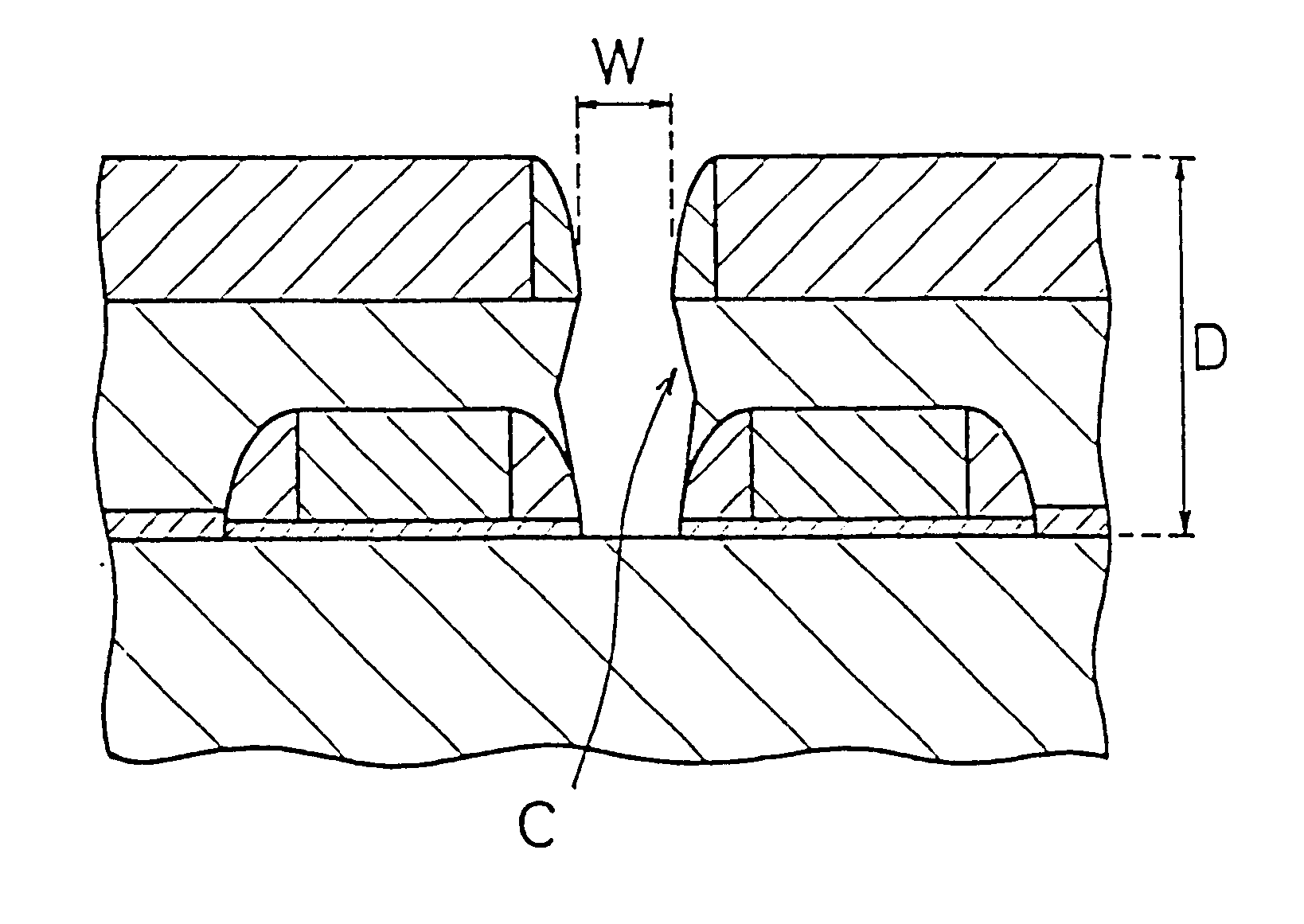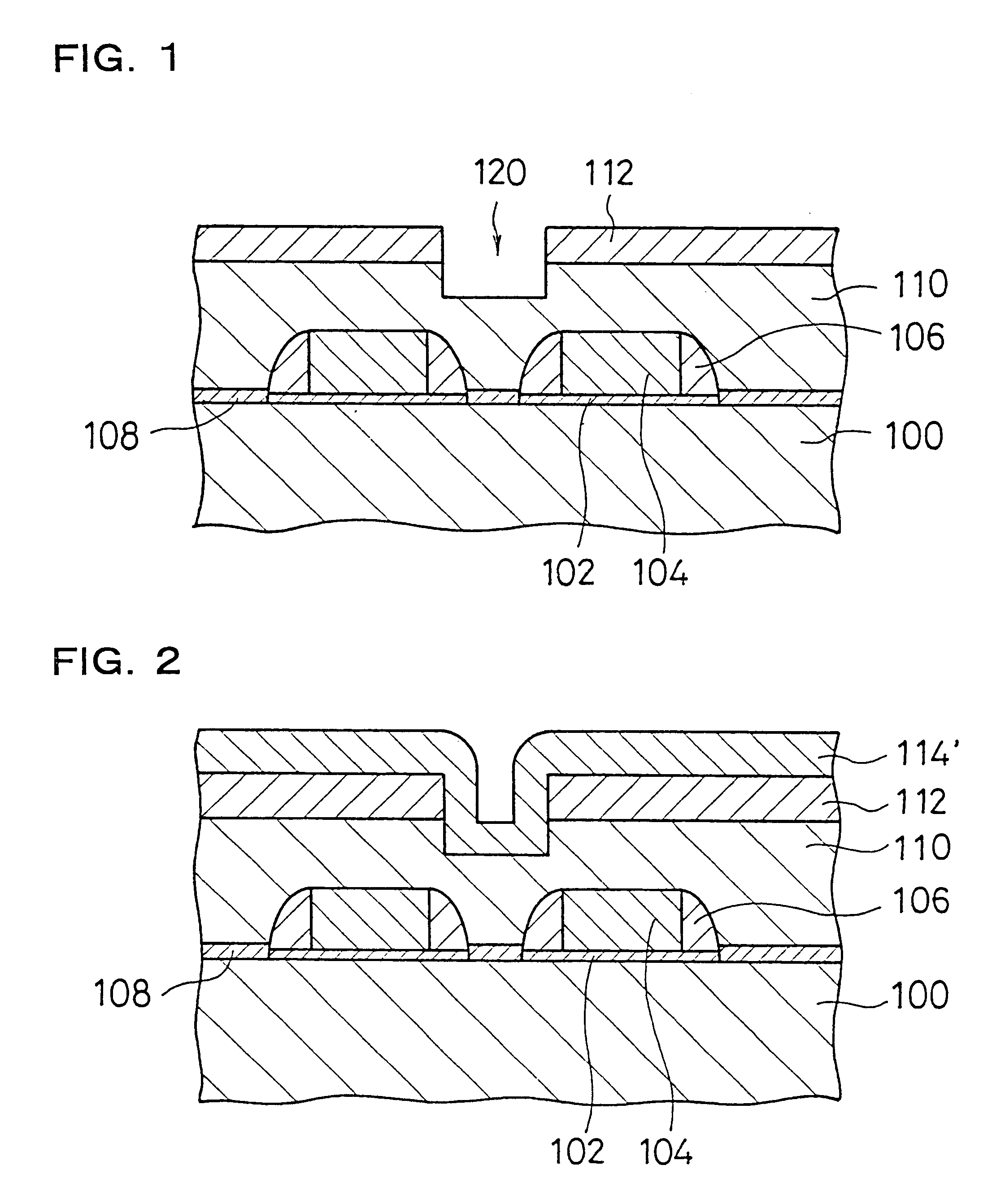Semiconductor device and method for manufacturing semiconductor device
a semiconductor and semiconductor technology, applied in the direction of cable/conductor manufacture, electric devices, decorative surface effects, etc., can solve the problems of reducing the resolution occurring during the photolithography step, increasing the degree of integration and the film thickness of the insulating layer, and increasing the resolution
- Summary
- Abstract
- Description
- Claims
- Application Information
AI Technical Summary
Benefits of technology
Problems solved by technology
Method used
Image
Examples
first embodiment
First, the first embodiment is explained in reference to FIGS. 1.about.5. It is to be noted that FIGS. 1.about.5 mainly illustrate the steps taken in the method for manufacturing a semiconductor device in this embodiment.
The method for manufacturing a semiconductor device in the embodiment may be primarily divided into four steps, i.e., an element formation step, an insulating layer formation step, a mask formation step, and a contact hole formation step.
As illustrated in FIG. 1, during the element formation step, a specific element active area is first formed at a silicon substrate 100 which corresponds to the semiconductor substrate. Next, gate oxide film 102 is grown with a specific pattern at the front surface of the silicon substrate 100. Then , polysilicon gates 104 are grown on the gate oxide film 102 to form a gate pattern. Next, a CVD silicon oxide film 106 is grown at side walls of the polysilicon gates 104 to form a side wall spacer pattern. Then, a silicon oxide film 108...
second embodiment
Next, the second embodiment is explained mainly in reference to FIGS. 6.about.9.
In the method for manufacturing a semiconductor device in this embodiment, first, element active areas are formed on a silicon substrate 200, silicon oxide film 202 is grown and a pattern of polysilicon gates 204 constituted of polysilicon is formed as illustrated in FIG. 6. Next, side wall spacers 206 are formed at side walls of the polysilicon gates 204 to form a side wall spacer pattern, then a silicon oxide film 208 is formed at exposed portions of the silicon substrate 200 and specific diffusion layers are formed at the silicon substrate 200 through impurity ion implantation (the diffusion layers are not shown).
Next, a first BPSG film 210a is deposited over the entire surface and is planarized through hot flow, and then a silicon nitride film 220, which corresponds to an etching stop layer is deposited. Then, a second BPSG film 210b is deposited and planarized through hot flow. After this, a polysil...
third embodiment
Next, the third embodiment is explained in reference to FIGS. 10.about.13.
In this embodiment, first, specific element active areas are formed on a silicon substrate 300, a gate oxide film 302 is grown and a pattern of polysilicon gates 304 constituted of polysilicon is formed as illustrated in FIG. 10. After forming side wall spacers 306 at the side walls of the polysilicon gates 304, a silicon oxide film 308 is formed at the exposed portion of the silicon substrate 300 and a specific diffusion layer is formed on the silicon substrate 300 through impurity ion implantation (the diffusion layer is not shown).
Next, a BPSG film 310 is deposited over the entire surface and is planarized through hot flow, and after this, a polysilicon film 312 to constitute a first layer and a silicon nitride film 320 to constitute a second layer are sequentially deposited. Then, through conventional photolithography and etching processes, a preparatory hole 322 which constitutes an initial preparatory ho...
PUM
| Property | Measurement | Unit |
|---|---|---|
| diameter | aaaaa | aaaaa |
| specific thickness | aaaaa | aaaaa |
| specific depth | aaaaa | aaaaa |
Abstract
Description
Claims
Application Information
 Login to View More
Login to View More - R&D
- Intellectual Property
- Life Sciences
- Materials
- Tech Scout
- Unparalleled Data Quality
- Higher Quality Content
- 60% Fewer Hallucinations
Browse by: Latest US Patents, China's latest patents, Technical Efficacy Thesaurus, Application Domain, Technology Topic, Popular Technical Reports.
© 2025 PatSnap. All rights reserved.Legal|Privacy policy|Modern Slavery Act Transparency Statement|Sitemap|About US| Contact US: help@patsnap.com



